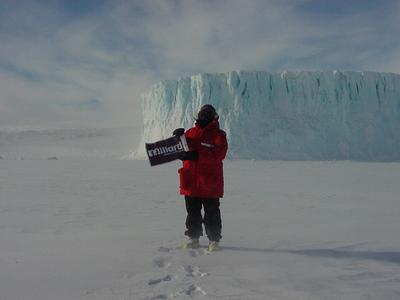8 November, 2000
FYI answer for 11/07/00
Glaciers are ice masses that are attached to land. When a glacier breaks away from the land and falls into the sea, it is called 'calving' and the glacier is now an iceberg.
There is something to be said about 'Being prepared'. I was prepared to go through my sea ice training today. I wasn't prepared for some other events that occurred. There were nine students and an instructor. We left McMurdo Station by 9:30 a.m. and headed out to the sea ice of the Ross Sea. We were traveling in a vehicle called a Haglund. It is like two tanks with windows, hooked together. Both compartments of a Haglund are normally heated, but today the back compartment did not have a heater that worked. (This would come to pose a problem later.) We had a short forty-five minute drive out to an instructor's hut that is placed out on sea ice so we can become familiar with our surroundings and how they relate to instruction. We spent an hour and a half learning about the ways that sea ice forms cracks and the types of cracks that we would find.
There are four basic types of cracks: tidal, straight or working, proximity, and pressure ridges. The tidal cracks are found where tides would come in and go out. They are smaller cracks that pose more danger for walking over then driving over and they are usually dry. (There is no water in them if you step through the layer of ice or snow that covers them.) Straight or working cracks are a little larger and are mostly dry. These cracks are large enough for vehicles to get stuck in or even fall all the way into, no matter what the size. Proximity cracks are the most difficult to see because of thin layers of recent water freezing into the tops of these cracks. Vehicles can also be in danger around proximity cracks, especially because they may be heavy enough t break through that top layer. Pressure ridges are massive ice forms that have been pushed together and thrust into chaotic patterns of elevations and depressions. Vehicles cannot travel over pressure ridges, but riding snowmobiles and walking through bridged portions may be
possible.
We talked and listened through the steps of looking for cracks and how to get across them, when that is an option. The tools to do this job consist of an ice axe, a shovel, and an ice drill or auger. We then went out and put the class talk to hands-on work. Along the way we stopped long enough to see 'bergy bits', which are small icebergs. These, of course, were frozen right into the sea ice. After teamwork to complete three ice crack finds, a tidal crack, a wet working crack and a proximity crack, we discovered that our Haglund had a hydraulic leak and we couldn't steer anymore. This left us stranded more than an hour and a half from McMurdo.
The winds were increasing as the first hour of trying to find the leak went by. When it's cold and the wind blows, there is wind-chill. The back compartment of the Haglund didn't have heat. Only four people can fit in the front. It was time for more clothes and the emergency stoves to heat water for hot drinks to warm the body. Most of us also walked around taking pictures of the scenery, which included the magnificent Barnes Glacier. After another two hours, thanks to the talents of teamwork amongst us, we did get our leak fixed long enough to get back to McMurdo. Those of us in the back compartment of the Haglund did not have a warm ride though.
I knew that once I had my sea ice training I was going to join my fieldcamp team. I didn't know they would literally be waiting for me when I got back. They were, and so I packed up my bags and headed out to Big Razorback Island at 12:00 a.m.! The trip is one hour by snowmobile. We arrived by 1:00 a.m. I was introduced to the rest of my team and went to bed around 3:00a.m.
FYI
Sea ice is the _____________ surface of the ocean. It mets with the spring and________________ thaw and ______________ with the fall and winter chill. During these changes, there is a larger increase in cracks and ice holes. The Ice Shelf is a massive _______ sheet that is always attached to the continent. There are seasonal crack changes but its _______________ is generally very slow over the years.

This is a real glacier Barnes Glacier

This is a Haglund

We are drilling to see how deep the crack is

This is a real glacier; Barnes Glacier
Contact the TEA in the field at
.
If you cannot connect through your browser, copy the
TEA's e-mail address in the "To:" line of
your favorite e-mail package.
|
